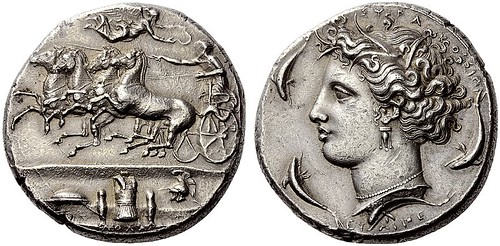
A Rare and Magnificent Greek Silver Dekadrachm of Syracuse (Sicily), Signed by Euainetos, Among the Finest Examples Known, a Masterpiece of Greek Numismatics, a photo by Ancient Art on Flickr.
Via Flickr:
SICILY
SYRACUSE, Dionysius I, 406–367. Decadrachm c. 400 BC, Attic standard, AR 43.40 g. Work signed by the engraver Euainetos. Obv. Quadriga galloping left, driven by charioteer holding kentron in right hand and reins in left, crowned by Nike flying right; in exergue, suit of defensive armour consisting of shield, cuirass between two greaves, and helmet. Rev. SU-PA-K-O-SIWN / EU-AINE Head of the nymph Arethusa left, crowned with reed-wreath, wearing triple-drop earring and necklace; around, four dolphins; border of dots. Literature BMC Sicily - cf. 171, 176–181 (legend differently subdivided) SNG ANS 364–366 SNG München 1075 Baumann 142 A. Gallatin, Syracusan Dekadrachms of the Euainetos Type, Cambridge Mass, 1930, RIII/CI Antikenmuseum Basel 480 Jameson 828 M.-M. Bendenoun, Coins of the Ancient World, A Portrait of the JDL Collection, Tradart, Genève, 2009, 7 (this coin). Condition Very rare and among the finest specimens known of this desirable and important issue. Perfectly struck and exceptionally complete, light iridescent tone.Good extremely fine. Provenance Tkalec AG, Zürich 1996, lot 13. Note Coins of the artist Euainetos are among the most exquisite works of art from the ancient Greek world. Of special value are his decadrachms, which must have been distributed widely, for they were influential to artists in regions far removed from the shores of Sicily. It is unlikely that many were exported through the normal channels of commerce, and we might suggest that, much like the staters of Olympia, some were acquired as keepsakes and were carried to a variety of destinations. The decadrachms of Kimon and Euainetos were introduced early in the reign of the tyrant Dionysius I (405-367 B.C.), and those of Euainetos continued to be struck for decades, perhaps even beyond the 360s. We might presume that Dionysus took a personal interest in producing such large coins of fine style to evince his patronage of the arts and to promote the success of his rule. There is also good reason to believe that after the Euainetos’ initial contributions, die cutting for the series eventually was carried out by understudies and successors. In some cases Euainetos’ signature appears to have been retained as a fixed element of the design until about midway through, when it was lost altogether. In general, these understudies meticulously copied the work of the master engraver. Gallatin notes that the entire series “...shows a most amazing repetition of the details of the arrangement of the hair, locks and curls being slavishly repeated.” Though a precise context has not been convincingly established for the Syracusan decadrachms of Kimon and Euainetos, it is tempting to associate their introduction with a military victory. The display of armour and weaponry that appears in the exergue is militant, and the inscription AΘΛA, which indicates ‘prizes,’ or at least ‘agonistic contests,’ only adds to that prospect. Since it was a common practice of Greek soldiers to engrave dedicatory inscriptions on captured armour, a connection might be drawn between that phenomenon and what is presented on the decadrachms. The obverse also appears to allude to victory with its vivid scene of a charioteer guiding his team through a bend. The dies used to strike this particular decadrachm almost certainly were the work of Euainetos himself, for they are each the third in the series. This coin was struck from the first die in the series on which the engraver’s name is presented in the usual truncated form EYAINE, as the two dies that seem to have preceeded this one bear an expanded signature, either EYAINETOY or EYAINETO.
NAC74, 281
Niciun comentariu:
Trimiteți un comentariu